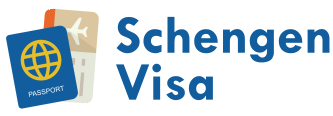Regardless of the Schengen country you plan to visit or the type of Schengen visa you want to apply for, you will have to fill out the same Schengen visa application form as part of your visa application. That is why authorities refer to this form as ‘harmonized’.
This application form comes with 32 questions. Apart from biographical info like your name, birthdate, and address, you also have to provide more information about your planned visit to the Schengen region – like how you intend to pay the costs involved with the trip, where you will be staying, and the type of visa you are applying for. False or incorrect answers can cause your application to be rejected.
Where can I get a copy of the Schengen visa application form?
The country from where you are applying will determine how you are able to access the application form. Some consulates or embassies will send you a link where you can download the form and have it printed. Others will direct you to an e-portal where you can enter your information online and submit it directly.
The questions on the application form and how to answer them correctly
1. Surname (Family name) – Start filling out the form by entering your surname. Depending on where you live, you might know it better as your family name. If you are a female and have been married more than once, you should use your current surname. In all cases, the surname you enter here should match the one on your passport.
2. Surname at birth (Former family name) – If your current surname differs from the one that you were born with, enter the surname that you were born with here. The most obvious example is when your surname changed because you were married. In that case, you should enter the surname were born with in this field.
3. First name(s) (Given name(s)) – This is where you enter your full first name. This is NOT the place to enter your nickname or any other shortened version of your first name, stick to your full legal first name as it appears on your passport.
4. Date of birth (day-month-year) – In this field enter the exact date on which you were born in the following format: Day, month, year. If you were, for example, born on December 25, 1992, enter 25/12/1992.
5. Place of birth – Here you should enter the name of the city in which you were born, also as it appears on your passport.
6. Country of birth – Enter the name of the country in which you were born. Do not leave this field blank, even if the country’s name does not appear on your travel document (e.g. passport).
7. Current nationality/Nationality at birth, if different/Other nationalities – In this field you have to enter your present nationality. If this differs from your nationality at birth, you should also provide your original nationality. Applicants holding more than one nationality should enter these in this field.
8. Sex – In this checkbox you have to choose either ‘male’ or ‘female’ – there are no other alternatives.
9.Marital status – Here you have to choose your current marital status from a list of checkboxes. The options are straightforward: single, married, registered partnership, separated, divorced, widow or widower. If none of these options applies to you, choose ‘other’ and briefly explain your choice.
10. Parental authority (in case of minors) /legal guardian (surname, first name, address, if different from applicant’s, telephone no., e-mail address, and nationality) – You can leave this field blank if you are no longer a minor, i.e. if you are 18 or older. If you are under 18, this is where you have to provide the full name, address, and nationality of your parent or legal guardian.
11. National identity number (where applicable) – Here enter your identity number as it appears on the official identity document issued by the government of your country. If your country does not issue its citizens with national identity numbers, you can leave this field blank, or enter n/a, i.e. not applicable.
12. Type of travel document – Check one of the six boxes. Choose the one that best describes your current passport. The options include the following:
- Ordinary passport
- Diplomatic passport
- Service passport
- Official passport
- Special passport
- Other travel document
Unless you are a diplomat or government official, you probably have an ordinary passport. In the unlikely scenario that none of the above provides an accurate description of your passport, or if you are travelling with a travel document other than a passport, select ‘Other travel document’ and give a brief explanation in the space provided.
13. Number of travel document – The vast majority of passports and other travel documents have a number. If you are travelling with a passport, the number will be printed on one of the inside pages, typically on the same page where your photo appears.
14. Date of issue – This is where you enter the date on which your passport or other travel document was issued. In the case of passports, this date will typically be located on one of the inside pages, often on the same page where your photo appears. Please take care not to enter the passport’s extension date here!
15. Valid until – This field requires you to enter your passport’s or other travel document’s expiration date. In the case of passports, it will normally be located on one of the inside pages, normally on the same page where your photo appears.
16. Issued by (country) – Here you should enter the name of the country where your passport was issued. If you can’t find a title called ‘issuer’, you might find it under something like ‘authority’ or ‘passport authority’.
17. Personal data of the family member who is a European Union, EEA or Swiss Confederation citizen or a United Kingdom citizen beneficiary of the withdrawal agreement, if applicable – You do not have to complete this section if you do not have a family member who has citizenship status in the EU, EEA, or Swiss Confederation, or who is a UK beneficiary of that country’s withdrawal agreement with the EU.
If you do, this is where you have to enter their surname, first name, date of birth, nationality, and the number of their travel document or ID card.
18. Family relationship with a European Union, EEA or Swiss Confederation citizen, or with a United Kingdom citizen beneficiary of the withdrawal agreement, if applicable – There are six checkboxes here. Select the one that best describes the nature of your relationship to the particular family member. If none of the first five options accurately describes the relationship, check the last one (other) and give more detail in the space provided.
19. Applicant’s home address, email address and telephone number – In this section, you have to provide the address where you presently live, even if it is temporary. Also, enter a valid email address and phone number. Make 100% sure this information is correct so the officials will be able to contact you if they need additional information.
20. Residence in a country other than the country of current nationality – Select No or Yes to specify whether or not you currently live in a different country than the one of which you are a national. If yes, enter the resident permit’s number as well as the date when it expires.
21. Current occupation – Enter your profession, e.g. ‘doctor’ or ‘factory worker’ or ‘student’. If you are unemployed, write ‘no occupation’.
22. Employer and employer’s address and telephone number. For students, name and address of educational establishment – Enter the name and contact details of your current employer or, if you are a student, the place where you are studying, so they can be contacted if necessary.
23. Purpose(s) of the journey – From the 10 options, choose the checkbox that best describes the purpose of your journey. If your trip has two equally important reasons, e.g. ‘tourism’ and ‘visiting family or friends’, select both. If the purpose of your trip is not listed, select ‘other’ and briefly explain.
24. Additional information on purpose of stay – If you feel you should provide additional information about your reasons for this trip, enter it here.
25. Member State of main destination (and other Member States of destination, if applicable) – Here enter the name of the Schengen country where you will spend the most time, even if it is not the one where you will first arrive.
26. Member State of first entry – This field is for the name of the country where you will first arrive in the Schengen region, even if you will only be transiting to another Schengen country.
27. Number of entries requested – If you plan to enter the Schengen region and stay there for the whole trip, choose ‘single entry’. If you want to leave once and then come back again, choose ‘two entries’. The option for ‘multiple entries’ should be selected if you want to leave and come back several times during your visa period. Also, enter the date on which you will first arrive in the Schengen region and the date on which you will first leave (even if you will be coming back later).
28. Fingerprints collected previously for the purpose of applying for a Schengen visa – If your fingerprints have been taken before when you applied for a Schengen visa, choose ‘yes’ and enter the date when it happened and the sticker number of the visa (if you still have that info). If the answer is ‘no’, and you are older than 12 years, you will most likely have to submit fingerprints.
29. Entry permit for the final country of destination, where applicable – This is about where you will be going when leaving the Schengen area. If you are, for example, flying to another country where you need a visa to enter, you have to provide the name of that country and the dates for which the visa is valid.
30. Surname and first name of the inviting person(s) in the Member State(s). If not applicable, name of hotel(s) or temporary accommodation(s) in the Member State(s) – In short, this is where you have to enter the name and contact information of the individual or accommodation establishment (e.g. hotel, guest house) where you will be staying in the Schengen region.
31. Name and address of inviting company / organisation – If a company or organisation invited you to a Schengen country (e.g. for business purposes) this is where you should provide that company’s name and address, and the full contact details of your contact person in the company.
32. Cost of travelling and living during the applicant’s stay is covered – This has to do with how you will be supporting yourself financially during your visit to the Schengen region. If you will be paying for everything yourself, choose the ‘by the applicant himself/herself’ option and then select how you will do this, e.g. cash, traveller’s cheques, credit card, etc. or choose ‘other’ and give more information.
If you have someone who is helping to cover the expenses related to your visit, select ‘by a sponsor (host, company, organisation’. If this is the same person or company you mentioned under questions 30 or 31 above, select that checkbox or give more details in the ‘other’ field. Then select whether this support will be in the form of cash, accommodation provided, covering your expenses during the trip, pre-paid transport, or another way. If you choose ‘another way’ you have to specify what it is.
Conclusion
The questions on the Schengen Visa Application Form can be a challenge for applicants. Thus, we advise travellers to read through the form several times so that they clearly understand the requested information. Applicants should ensure they have obtained the necessary documents and / or other evidence needed to support their application prior to starting the form.




